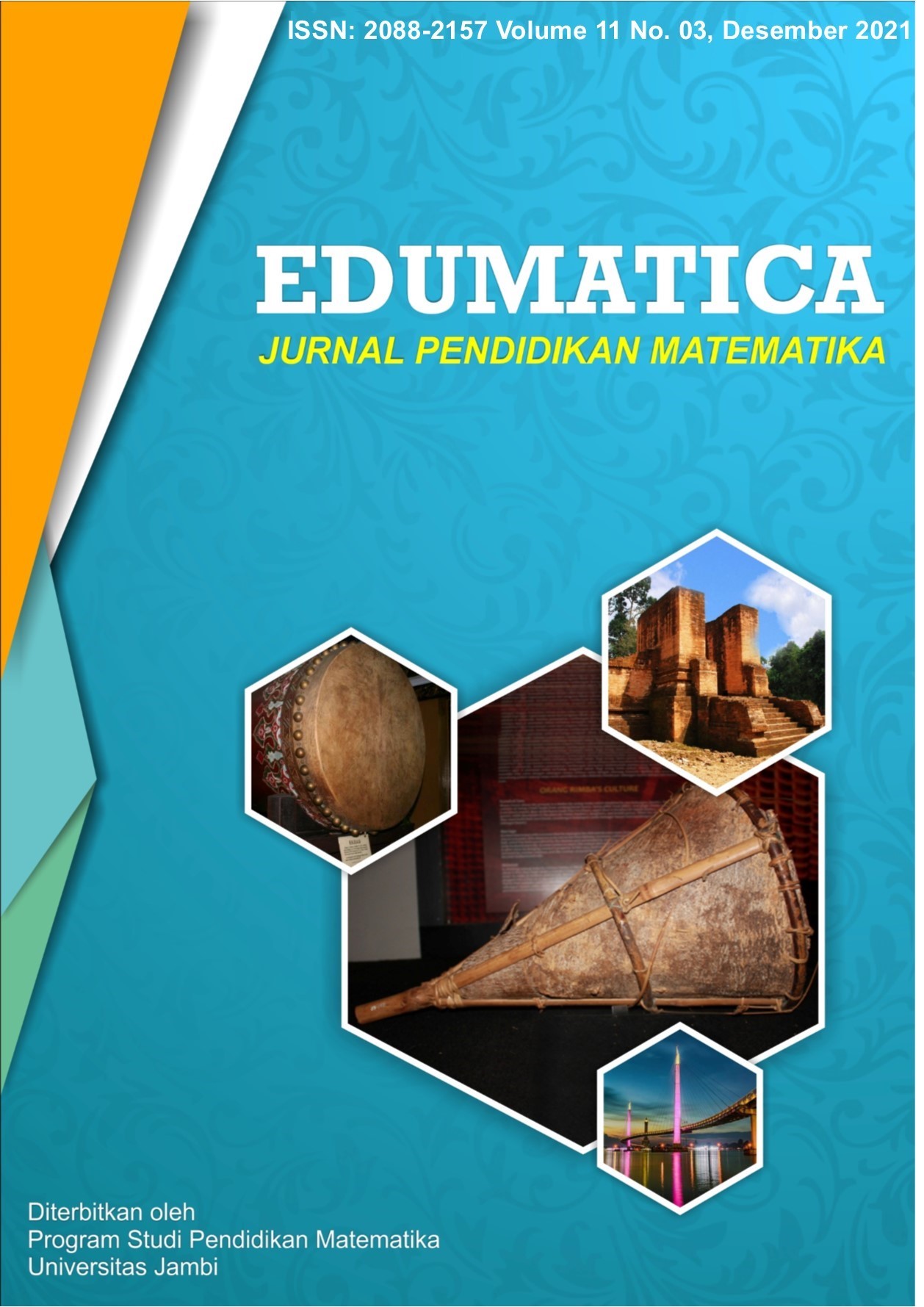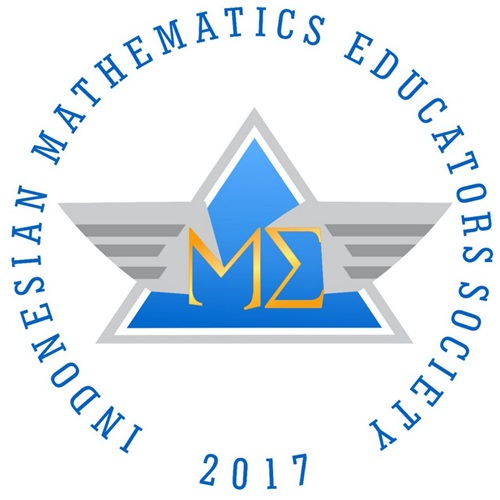Indonesian Mathematics Teachers' Responses to the Continuity of the Students Learning during Pandemic
DOI:
https://doi.org/10.22437/edumatica.v11i03.14077Keywords:
distance learning, inclusive learning, pandemicAbstract
The continuity of student learning in the midst of a pandemic is important. This encourages teachers to choose priorities in implementing distance learning. Teachers' efforts to accommodate inclusive learning in the midst of social and economic challenges and gaps in distance learning are a step in realizing student learning sustainability in the midst of a pandemic. The research conducted on 374 Mathematics teachers in Indonesia aims to determine the responses of Mathematics teachers to the continuity of student learning during the pandemic. These responses are seen from the teacher's priorities in distance learning and the efforts made in implementing inclusive learning during the pandemic. This research is descriptive research. Sampling was done using snowball sampling technique. Data collection was done by distributing online questionnaires. Several semi-open questions were asked which were then analyzed qualitatively using the Miles and Huberman framework and using descriptive statistics. The results showed that 81,18% teachers still prioritize the right of students to continue to acquire knowledge, by not pursuing the achievement of curriculum targets. To accommodate these student rights, teachers were encouraged to carry out inclusive learning. As many 100% teachers tended to apply the principles of flexible learning and 0,94% teachers collaborated with the student's parents by apllying the type of communication initiated by Epstein, namely by designing effective communication with parents through home visit activities.
Downloads
References
Arifa, F. N. (2020). Tantangan Pelaksanaan Kebijakan Belajar Dari Rumah Dalam Masa Darurat Covid-19. Info Singkat;Kajian Singkat Terhadap Isu Aktual Dan Strategis, 7(6), 13-18. Retrieved from http://berkas.dpr.go.id/puslit/files/info_singkat/Info Singkat-XII-7-I-P3DIApril-2020-1953.pdf
Bektiningsih, K., Trimurtini, T., Muslikah, M., Widihastrini, F., & Susilaningsih, S. (2020). Model Pendidikan Inklusi dan Implementasinya pada Masa Pandemi COVID-19 di Sekolah Dasar. Jurnal Pemberdayaan: Publikasi Hasil Pengabdian Kepada Masyarakat, 4(3), 259. https://doi.org/10.12928/jp.v4i3.2868
Bhayangkara, A. N., Firdaus, D. B., Ahmadi, W. H., & Sumarsono, R. B. (2020). Home Visit Based on Flipped Class Learning in The Process of Maintaining DNA of Peak Performance Students in the Era of Pandemic. Proceedings of the 1 St International Conference on Information Technology and Education (ICITE 2020). Paris, France: Atlantis Press. https://doi.org/10.2991/assehr.k.201214.232
Daniel, S. J. (2020). Education and the COVID-19 Pandemic. PROSPECTS, 49(1-2), 91-96. https://doi.org/10.1007/s11125-020-09464-3
Epstein, J. L. (2010). School/Family/Community Partnerships: Caring for the Children We Share. Phi Delta Kappan, 92(3), 81-96. https://doi.org/10.1177/003172171009200326
Everitt, B. S., & Skrondal, A. (2010). The Cambridge Dictionary of Statistics (4th ed). Cambridge University Press.
Filler, J., & Xu, Y. (2006). Including Children with Disabilities in Early Childhood Education Programs: Individualizing Developmentally Appropriate Practices. Childhood Education, 83(2), 92-98. https://doi.org/10.1080/00094056.2007.10522887
Florian, L., & Linklater, H. (2010). Preparing Teachers for Inclusive Education: Using Inclusive Pedagogy to Enhance Teaching and Learning for All. Cambridge Journal of Education, 40(4), 369-386. https://doi.org/10.1080/0305764X.2010.526588
Graham, A., & Sahlberg, P. (2020, March). Schools are Moving Online, but not All Children Start Out Digitally Equal. The Conversation. Retrieved from https://theconversation.com/schools-are-moving-online-but-not-all-children-start-out-digitally-equal-134650
Hill, J. R. (2006). Flexible Learning Environments: Leveraging the Affordances of Flexible Delivery and Flexible Learning. Innovative Higher Education, 31(3), 187-197. https://doi.org/10.1007/s10755-006-9016-6
Huang, R., Liu, D., Chen, C., Zeng, H., Yang, J., Zhuang, R., … Zhao, J. (2020). Handbook on Facilitating Flexible Learning During Educational Disruption: The Chinese Experience in Maintaining Undisrupted Learning in COVID-19 Outbreak. Beijing: Smart Learning Institute of Beijing Normal University.
Kementerian Pendidikan dan Kebudayaan. (2020). Surat Edaran mengenai Pelaksanaan Pendidikan Dalam Masa Darurat Coronavirus Disease (Covid-19).
Kementrian Komunikasi dan Informatika Republik Indonesia. (2020). Kominfo Bangun 4200 BTS Demi Desa Teraliri Internet di 2021.
Mailizar, M., Almanthari, A., Maulina, S., & Bruce, S. (2020). Secondary School Mathematics Teachers’ Views on E-learning Implementation Barriers during the COVID-19 Pandemic: The Case of Indonesia. Eurasia Journal of Mathematics, Science and Technology Education, 16(7), em1860. https://doi.org/10.29333/ejmste/8240
Miles, M., Huberman, A., & Saldana, J. (1994). Qualitative Data Analysis (3rd ed.). United States: SAGE Publications, Inc.
Moore, J. L., Dickson-Deane, C., & Galyen, K. (2011). E-Learning, Online Learning, and Distance Learning Environments: Are They the Same? The Internet and Higher Education, 14(2), 129-135. https://doi.org/10.1016/j.iheduc.2010.10.001
Mustapha, I., Van, N. T., Shahverdi, M., Qureshi, M. I., & Khan, N. (2021). Effectiveness of Digital Technology in Education During COVID-19 Pandemic. A Bibliometric Analysis. International Journal of Interactive Mobile Technologies (IJIM), 15(08), 136. https://doi.org/10.3991/ijim.v15i08.20415
Navarro, S. B., Zervas, P., Gesa, R. F., & Sampson, D. G. (2016). Developing Teachers’ Competences for Designing Inclusive Learning Experiences. Journal of Educational Technology & Society., 19(1), 17-27.
Ngadi, N., Meliana, R., & Purba, Y. A. (2020). Dampak Pandemi COVID-19 terhadap PHK dan Pendapatan Pekerja di Indonesia. Jurnal Kependudukan Indonesia, 43-48. https://doi.org/10.14203/jki.v0i0.576
Onyema, E. M., Nwafor, C., Obafemi, F., Sen, S., Atonye, F. G., Sharma, A., & Alsayed, A. O. (2020). Impact of Coronavirus Pandemic on Education. Journal of Education and Practice, 11(13), 108-121. https://doi.org/10.7176/JEP/11-13-12
Purwanto, A., Pramono, R., Asbari, M., Hyun, C. C., Wijayanti, L. M., Putri, R. S., & Santoso, P. B. (2020). Studi Eksploratif Dampak Pandemi COVID-19 Terhadap Proses Pembelajaran Online di Sekolah Dasar. Journal of Education, Psychology and Counseling, 2(1), 1-12. Retrieved from https://ummaspul.e-journal.id/Edupsycouns/article/view/397
Reimers, F. M., & Schleicher, A. (2020). A Framework to Guide an Education Response to the COVID-19 Pandemic of 2020. Review of Educational Research, 66(3), 227-268.
Rianasari, V. F., Julie, H., & Apriani, M. S. (2021). Indonesian Mathematics Teachers’ Responses Towards the Implementation of Distance Learning During Covid-19 Pandemic. Advances in Social Science, Education and Humanities Research, 383-390. Atantis Press. https://doi.org/10.2991/assehr.k.210305.055
Ro’fah, R., Hanjarwati, A., & Suprihatiningrum, J. (2020). Is Online Learning Accessible During COVID-19 Pandemic? Voices and Experiences of UIN Sunan Kalijaga Students with Disabilities. Nadwa, 14(1), 1-38. https://doi.org/10.21580/nw.2020.14.1.5672
Rofiah, N. H., Sudiraharja, D., & Ediyanto, E. (2020). The Implementation Inclusive Education: Implication for Children with Special Needs in Tamansari Elementary School in Yogyakarta. International Journal of Educational Management and Innovation, 1(1), 82. https://doi.org/10.12928/ijemi.v1i1.1517
Sahlberg, P. (2021). Does the Pandemic Help Us Make Education More Equitable? Educational Research for Policy and Practice, 20(1), 11-18. https://doi.org/10.1007/s10671-020-09284-4
Stone, C., Freeman, E., Dyment, J., Muir, T., & Milthorpe, N. (2019). Equal or Equitable? The Role of Flexibility within Online Education. Australian and International Journal of Rural Education, 29(2), 26-40. Retrieved from https://eprints.utas.edu.au/30857/
Ulfa, Z. D., & Mikdar, U. Z. (2020). Dampak Pandemi Covid-19 terhadap Perilaku Belajar, Sosial dan Kesehatan bagi Mahasiswa FKIP Universitas Palangka Raya. JOSSAE : Journal of Sport Science and Education, 5(2), 124. https://doi.org/10.26740/jossae.v5n2.p124-138
UNESCO IBE [International Bureau of Education]. (2016). Reaching Out to All Learners: A Resource Pack for Supporting Inclusive Education, Training Tools for Curriculum Development.
UU No. 10 Tahun 1998. Presiden republik indonesia. , Peraturan Pemerintah Republik Indonesia Nomor 26 Tahun 1985 Tentang Jalan § (2004).
Wajdi, M. B. N., Iwan Kuswandi, Umar Al Faruq, Zulhijra, Z., Khairudin, K., & Khoiriyah, K. (2020). Education Policy Overcome Coronavirus, A Study of Indonesians. EDUTEC : Journal of Education And Technology, 3(2), 96-106. https://doi.org/10.29062/edu.v3i2.42
World Bank. (2020). Guidance Note on Remote Learning and COVID-19 (English). Washington DC.
Zainal, N. H. (2020). Tantangan Kebijakan Pembelajaran Jarak Jauh di Era Pandemi Covid 19. Pencerahan, 14(2), 133-151. Retrieved from http://www.jurnalpencerahan.org/index.php/jp/article/view/31
Downloads
Published
How to Cite
Issue
Section
License
Copyright (c) 2021 Maria Suci Apriani, Veronika Fitri Rianasari, Hongki Julie

This work is licensed under a Creative Commons Attribution-NonCommercial-ShareAlike 4.0 International License.







